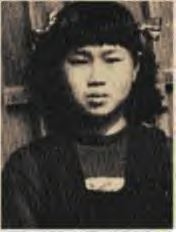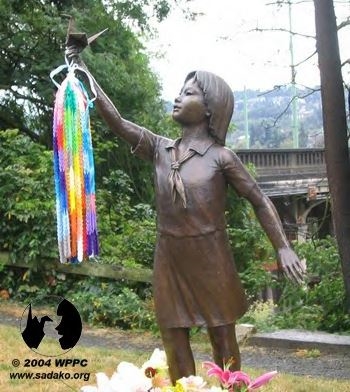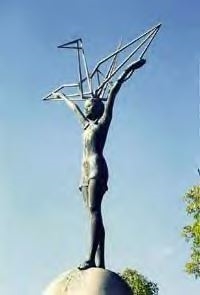 |
| Sadako Sasaki (http://www.johnworldpeacegalleries. com/1000cranes.html) |
Sadako Sasaki was two years old when the atomic bomb was dropped on Hiroshima, Japan on August 6, 1945. She and her family survived the immediate effects of the bomb, but several years later, when she was about 11 years old, Sadako was diagnosed with leukemia, the “atom-bomb disease.” Born on January 7, 1943, in Hiroshima, Japan, Sadako was as healthy as any other child until she began getting dizzy and finally collapsed while running in a race at her school. Diagnosed with leukemia, Sadako spent several long months in the hospital before she died at the age of twelve on October 25, 1955.
While in the hospital, Sadako’s best friend told her of an ancient Japanese legend that claimed the gods would grant a wish to anyone who folded a thousand paper cranes. Sadako prayed she would be well again, and she began folding paper cranes. She continued to fold hundreds and hundreds of cranes as she watched her friends die in the hospital alongside of her. Sadako came to realize that she wasn’t going to get well again, even if she did manage to fold a thousand paper cranes. So she changed her prayer. She prayed that if she could fold one thousand cranes, people would live in peace. She no longer wished for her own health but rather that there should be no more bombs or wars; her wish was for peace so that the people of the world would not have to suffer and die like she.
 |
| Sadako Statue in Seattle Peace Park (http://www.sadako.org/) |
Sadako only managed to fold 644 paper cranes before she died, but of each one of those, she said, “I will write Peace on your wings and you will fly all over the world.” After she died, her friends, family and classmates folded the remaining 356 paper cranes to bury with her. In 1958, a statue of Sadako holding a golden crane was unveiled in Hiroshima Peace Park as a reminder to the world of the impact of a nuclear war, and of the children’s prayer for peace. Inscribed at the bottom of the statue is the children’s wish, "This is our cry. This is our prayer. Peace in the world." Today, children all over the world fold paper cranes and send them to Hiroshima, where they are placed around the statue of Sadako. Because of Sadako, the paper crane has become an international symbol of peace.
I admire Sadako for her everlasting sense of hope and her wish for peace. She is but an innocent young girl that suffered the consequences of the actions of two countries at war, and yet she cared not about herself but about the world. Sadako was a very selfless girl, even at a time when most children would be concerned with only themselves, and I really respect her for it. Sadako was amazingly influential on those around her, restoring the sense of hope in those that had lost their hope for World Peace when the atomic bomb was dropped. She was stronger than her sickness, and was thus able to defy the death sentence of leukemia, as her legacy lives on in the hearts of those who have the same wish for peace she made so many years ago.
 |
| Sadako and the Golden Crane (http://www.pcf.city.hiroshima.jp/virtual/ VirtualMuseum_e/tour_e/ireihi/tour_16_e.html) |
The thing I most respect about Sadako is that instead of wasting her last days on the earth, she used them to make a great impact on the world. She didn't know it then, but she and her thousand paper cranes were to become international symbols of peace. Sadako stands proudly atop the Children's Peace Monument in Hiroshima Peace Park with her golden crane, crying out to the people of the world for peace. I pray that her cry will be heard around the world for generations to come and that Sadako's story will have as much of an impact on other people as it has on me. Sadako is my hero, and I hope her plea for peace withstands the sands of time until it can be answered someday.
Page created on 8/29/2011 12:00:00 AM
Last edited 8/29/2011 12:00:00 AM
